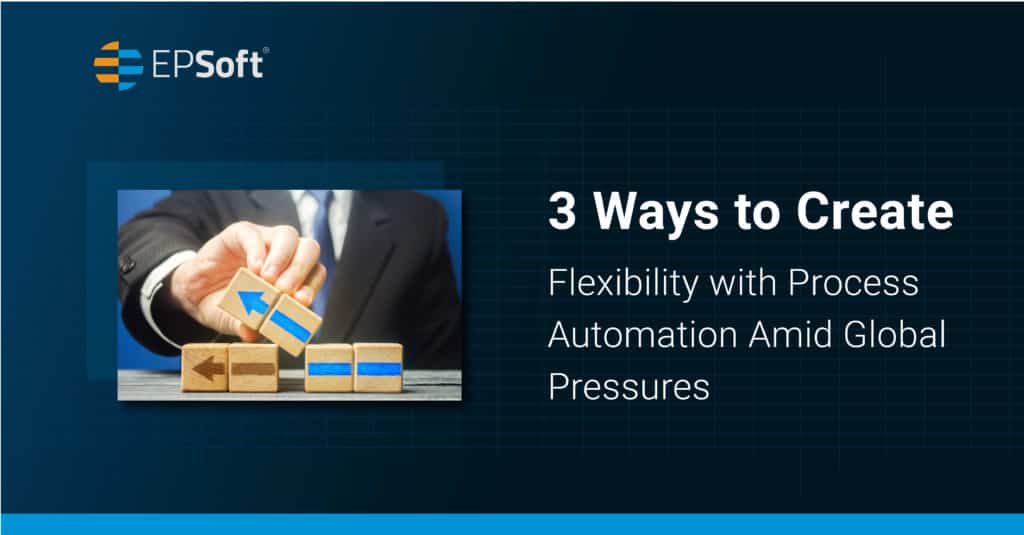As we collectively reel from conflict, inflation and evolving regulation, it’s fair to say these times are turbulent. While it feels intense, the truth is there will always be pressures. The players and details change with time, but the pressures are part of life. In business, adapting and adjusting are how we survive.
In today’s business climate, leaders need flexibility like they need revenue. Flexibility is critical because it acts as the counterweight to unpredictability. It’s how you create order from chaos, flexing and adapting.
Nowhere does this ring more true than in your business process—your internal network of workflows, projects and programs that determine how work gets done. Global circumstances constantly change, and you must be able to adapt your process to accommodate the shifts. Because when you don’t make these adjustments, workflows jam, production slows, and it puts all your teams under undue stress. To put it simply: Without flexibility, you can’t adjust to change.
One of the best ways to get more flexibility is through process automation. By automating what you can and optimizing what you can’t—more on that next—you create a flexible, agile and adaptable business process that can withstand even the most unpredictable events.
Sometimes, though, you have to shed some dependencies before you can start automating. Let’s take a look at why.
The Resource Dependence Dilemma
Sometimes in business, we engage with service providers outside the organization to gain internal resources or production capabilities. We call this resource dependence. While the resources may be advantageous to your operation, the dependency is a liability. Not only can these relationships cause kinks in your business process and user experience, but you also have little to no control to fix them. Worse still, you cannot automate any parts of a process you can’t manage. In other words, resource dependence limits your potential with process automation—and all the flexibility that comes with it. So, if the goal is to create flexibility with process automation, we need to limit resource dependence wherever possible. In many cases, that means taking more of your business productivity in-house.
But what if you’re not able to add more internal resources? That’s where we lean into process automation technology. With the help of RPA, process intelligence, and strategic business process management, you’ll gain the flexibility you need to respond to change, even when you didn’t plan for it.
Before implementing process automation, you need to prime your business for it. This includes aligning your teams with your business objectives and plotting your roadmap for the journey ahead. Of course, every journey will be different, depending on business circumstances, culture and other influences. But, in my experience, three prevailing factors help position your process automation journey for success. Together, they help you lay the foundation for what’s next.
-
Keep an employee-first mindset.
It’s easy to say you’re employee-first, but it takes a great deal of intentional action to practice it. Here’s why it’s essential to prioritize it: Your people are your business—they are the literal walking, breathing embodiment of the company. When they succeed, so does the business. So, when I say you need to put employees first, I’m not just talking about adding PTO and a suggestion box here. Employee-first means everything you do filters through that lens first.When we talk about improving business flexibility with automation, this extends to employee needs. How do their daily workflows work (or not) within the broader company business processes? Where can their loads be lightened for efficiency? Or make it even simpler—What tasks do they hate?
Putting employees first ensures you meet their needs across the board, which is the only way you can expect their help reaching company goals.
-
You hired smart people. Listen to them.
When unanticipated events hit, like record gas prices that upend supply chain costs, for example, it’s no secret they can cause a trickle-down effect. But it’s not just a temporary inconvenience. This kind of problem can pervade every aspect of business, derailing quarterly planning, stalling project timelines, and otherwise snagging business productivity. It may feel appropriate to leap into action and solve problems in times like these. But don’t do that. At least not immediately. I encourage you to resist the knee-jerk to do something and instead listen.Before you make plans, get input. What do your team leaders think? Managers? Employees? Where do they feel the pressure, and why? What do they think would help?
Naturally, not every suggestion is going to apply to your ultimate strategy. But, democratizing your response to unpredictable risks encourages buy-in for when changes are necessary. That’s because transparency creates a trusting environment: When employees understand why change is needed, and how it may benefit them directly, that change becomes an ally instead of a challenger. And it all starts with listening.
-
Look for (or create) your rising tide.
A rising tide lifts all boats, as they say. In your business process, this means finding the best options for improvement that will have the greatest impacts across the organization. Look for tasks that are repetitive, time-consuming, and redundant work—these are your star candidates for process automation. Think about tasks that are time-intensive and repetitive, like data entry, file retrieval, form fill and email routing.Ultimately, you can replace many of these individual tasks with process automation, making workloads lighter for employees, more measurable for managers, and all focused on the same established company goals. These opportunities make your efforts for improvement scalable, benefiting everyone across the enterprise.
The world is constantly changing around us, and many factors of our circumstances will always be beyond our control. That’s why it’s important to limit resource dependence and incorporate flexibility into what we can control with process automation. By leveraging technology and a smart process strategy, we can build business processes that can flex and adapt, come what may.
Book a demo with one of our process experts and get started on your process automation journey today!

